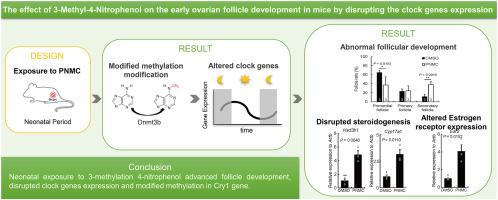Chemico-Biological Interactions ( IF 4.7 ) Pub Date : 2022-05-30 , DOI: 10.1016/j.cbi.2022.110001 Sijie Fan 1 , Xinyu Zhao 1 , Wenqian Xie 1 , Xiaoying Yang 1 , Wenyang Yu 1 , Zeqi Tang 1 , Yuan Chen 1 , Zhengrong Yuan 1 , Yingying Han 1 , Xia Sheng 2 , Haolin Zhang 1 , Qiang Weng 1

|
3-Methyl-4-Nitrophenol (PNMC) is the main degradation product of organophosphate insecticide fenitrothion and a major component of diesel exhaust particles, which is now becoming a widely spread environmental endocrine disruptor. Previous reports showed PNMC exposure can affect the female reproductive system and ovarian function; however, the mechanism remains unclear. The main purpose of this study is to clarify the mechanism underlying the adverse effects of neonatal PNMC treatment on ovarian functions. The neonatal female mice were exposed to 10 mg/kg PNMC and the ovaries were collected on the 7th day after birth. The changes of follicular composition in mice ovaries were analyzed by histological staining, which showed that the proportion of primordial follicles in the ovaries treated by PNMC decreased, while the proportion of secondary follicles increased. The ovarian function was also investigated by detecting the expressions of steroidogenic enzymes (Star, Cyp11a1, Hsd3b1, Cyp17a1, Cyp19a1), gonadotropin receptors (Fshr and Lhr), androgen receptor (Ar), and estrogen receptors (Esr1 and Esr2) by immunohistochemistry or/and real-time quantitative PCR. The expression of Hsd3b1, Cyp17a1 and Esr2 were increased significantly in the PNMC exposed ovaries. Moreover, the expression patterns of clock genes (Bmal1, Clock, Per1, Per2, Cry1, Cry2 and Nr1d1) were disrupted in the ovaries after PNMC exposure. Furthermore, either the expression of DNA Methyltransferase Dnmt3b, or the methylation ratio of CpG islands in the upstream of Cry1 promoter regions were significantly decreased in PNMC exposed ovaries. Altogether, these results indicate that PNMC exposure affects follicle development and ovarian function by interfering with the epigenetic modification and disrupting the expression of clock genes.
中文翻译:

3-甲基-4-硝基苯酚通过破坏时钟基因表达对小鼠早期卵泡发育的影响
3-甲基-4-硝基苯酚(PNMC)是有机磷杀虫剂杀螟硫磷的主要降解产物,是柴油机尾气颗粒的主要成分,目前正在成为一种广泛使用的环保型杀虫剂。内分泌干扰物。先前的报告显示,PNMC 暴露会影响女性生殖系统和卵巢功能;然而,机制仍不清楚。本研究的主要目的是阐明新生儿 PNMC 治疗对卵巢功能产生不良影响的机制。将新生雌性小鼠暴露于 10 mg/kg PNMC,并在出生后第 7 天收集卵巢。组织学染色分析小鼠卵巢中卵泡组成的变化,发现经PNMC处理的卵巢中原始卵泡比例降低,次级卵泡比例增加。还通过检测类固醇生成酶( Star , Cyp11a1 ,Hsd3b1、Cyp17a1、Cyp19a1 )、促性腺激素受体 ( Fshr和Lhr )、雄激素受体 ( Ar ) 和雌激素受体 ( Esr1和Esr2 ) 通过免疫组织化学或/和实时定量 PCR。Hsd3b1、Cyp17a1和Esr2的表达在 PNMC 暴露的卵巢中显着增加。此外,时钟基因(Bmal1、Clock、Per1、Per2、Cry1、Cry2和Nr1d1 )的表达模式) 在 PNMC 暴露后在卵巢中被破坏。此外,在暴露于 PNMC 的卵巢中,DNA 甲基转移酶 Dnmt3b 的表达或 Cry1 启动子区域上游 CpG 岛的甲基化比率显着降低。总之,这些结果表明,PNMC 暴露通过干扰表观遗传修饰和破坏时钟基因的表达来影响卵泡发育和卵巢功能。






























 京公网安备 11010802027423号
京公网安备 11010802027423号